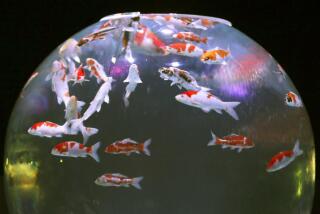ASIA / HOT SPOTS : Tiny Islands Stir Big Trouble in E. China Sea
- Share via
TOKYO — An old territorial dispute over a tiny cluster of uninhabited islands was reignited last month, threatening to upset Japan’s delicate balance of friendship with neighbors Taiwan and China--and revealing how raw Asian sensitivities still are over the legacy of Japanese militarism.
THE ISSUE--In dispute is a group of five islets and three coral reefs in the East China Sea about 130 miles northeast of Taiwan and 100 miles north-northwest of Ishigaki Island in Japan’s Okinawa prefecture. Lying 220 miles to the west is the Chinese mainland.
The Senkaku Islands, as they are called in Japanese, had of late attracted scant attention until early October. That was when the Maritime Safety Agency, Japan’s version of the coast guard, disclosed that it was ready to grant official status to a private lighthouse erected on one of those forlorn rocks by an obscure Japanese right-wing organization.
No further provocation was needed for an opposition politician in Taiwan to lead a landing party to the islands, called Diaoyutai in Chinese, with the intention of reasserting Taiwanese sovereignty by having athletes from a sports festival walk ashore with a torch. A television crew from Taipei recorded the scene Oct. 21 from a helicopter as Japanese Maritime Safety Agency ships chased away the two Taiwanese fishing boats.
REACTION--The incident sparked official complaints of “intrusion” from Tokyo and accusations of “unfriendly harassment” and “military expansionism” from Taipei. Protesters threw rotten eggs and burned a Japanese flag outside Tokyo’s unofficial representative office in the Taiwanese capital. Similar demonstrations occurred in Hong Kong.
Authorities in Beijing have been comparatively calm during the whole affair, but they reiterated China’s territorial claim to the islets. Beijing Radio carried a report last weekend saying China proposed jointly developing the islands with Japan and Taiwan.Tokyo reacted coolly.
The timing of the dispute could not have been worse for Tokyo, which is attempting to get legislation through Parliament that would permit personnel of the Japanese Self-Defense Forces to join peacekeeping efforts in the Persian Gulf. The bill has aroused fears of revanchism among Asian countries that fell victim to past Japanese expansionism.
AT STAKE--At the same time, Japan’s borders are not things taken lightly at home. A territorial dispute over four small islands off Hokkaido has been the major block to friendly relations with Moscow since the end of World War II.
The battle for the Senkakus pivots on national pride, but also at stake are rich fishing grounds and potential deep-sea oil deposits.
HISTORY--Japan first annexed the islands after it acquired Taiwan as a colony in 1895 at the end of the Sino-Japanese War. In 1972, when they established diplomatic ties, China and Japan disagreed on sovereignty but agreed to shelve the problem for “future generations to solve.”
In 1978, a right-wing group called the Nihon Seinensha flaunted Japan’s claim of sovereignty by building a lighthouse on the largest of the islets. After repairs were made to the lighthouse in 1988 and 1989, it won recognition as an official navigational facility.
OUTLOOK--What will happen next on the Senkaku Islands is not clear. A second Taiwanese opposition politician has vowed to sail back to the disputed islands with a flotilla of 300 fishing boats.
The Taiwanese military has declined to become involved, and Tokyo, too, has said it won’t use naval forces to patrol the area--only ships from the civilian Maritime Safety Agency.
More to Read
Sign up for Essential California
The most important California stories and recommendations in your inbox every morning.
You may occasionally receive promotional content from the Los Angeles Times.













